Distribution of heating pipes - we analyze all aspects of
Today, various operations related to the organization of heating the home have become available. For example, the distribution of heating pipes in a wooden house can be carried out independently, without the help of specialists. It is only important to know the specifics of the work, and in this connection we decided to tell you about this procedure in more detail.

Choosing a heat source and radiators
First of all, consider what the heat sources are. Much will depend on their choice.
So, today there can be three options:
- Wall mounted gas boiler. If there is a central gas supply, then this option is the most acceptable in terms of savings. Pipes will need to be diluted from the boiler throughout the house.
Interesting: now you can find many samples that are equipped with protection and automatic control systems. They are very safe.
- Electric boiler. Today it is the most popular option, because such a system can be mounted anywhere, the main thing is to have electricity. Moreover, it is quite easy to install it yourself.
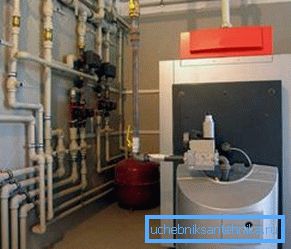
- The least popular option is a solid fuel boiler.. The main advantage is significant energy savings. However, if it is preferred, you should invite a specialist to connect, as this is a rather complicated process.
Choosing a suitable source of heat for you, you should think about the batteries.
In particular, they can be made from materials such as:
- Cast iron.
- Aluminum.
- Steel.
- Combined.
Each of them carries a wide range of advantages and disadvantages. You should not make a choice on such an aspect as the price. It is better to compare all the pros and cons, after consulting with experts.
Features of the choice of scheme
We now turn to the study of all the nuances of choosing a scheme. It should immediately be said that there are many criteria that must be taken into account. Therefore, our instructions will introduce you to all of them without exception.
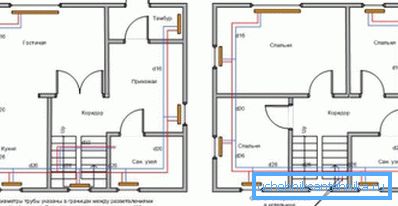
Regarding the construction of the building
First, we analyze all the features regarding the structure of the building.
This aspect should be addressed first.
- Single-story buildings should be equipped with a heating system with risers located vertically. And it does not matter whether there is a basement or not. This measure allows you to heat the attic, and it can be equipped if desired in the living room.
- If the house has a basement, and the roof has a gentle form, then it is best to use horizontal wiring. Such a scheme is most rational if the heat source is located in the basement (often it is there that will be left so as not to take the usable area). This measure will allow to achieve the best heat transfer and energy savings.
- In two-story buildings, we recommend using a two-pipe technique with vertically positioned risers. The type of layout does not matter here.
Options for supplying to radiators
To bring pipes to radiators can be various methods that have their own specific features.
We will also introduce you to them.
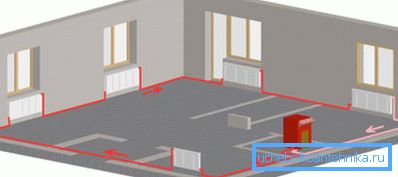
- Single pipe wiring of the heating system is the simplest option. In essence, this is a serial connection, as a result, a lower temperature will be supplied to each radiator next to the boiler. This technology significantly saves material, but as a result, the heating is uneven.
Note! If the house has more than two living rooms, then this technology should not be preferred. Otherwise it will be much colder in distant rooms.
- Collector - involves the installation of a special collector, from which the wiring is conducted. The result is a connection to each radiator separately, which creates uniform heating.
- Two-pipe - the most advanced technology (and the most expensive). Most often it is plinth layout. That is, laying around the perimeter of the building.
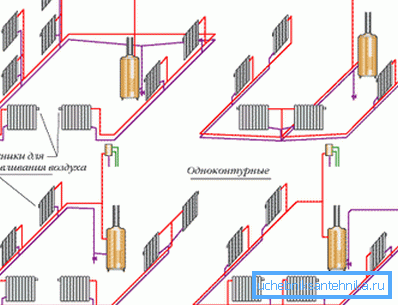
Of course, if funds allow, it is better to give preference to the latest technology. In this case, the house will be equally warm everywhere.
Connection method
The next aspect you will examine the type of connection.
In general, there may be only two options:
- Dependent - involves mixing the heat network with the coolant in the return pipe. Simply put, when water is supplied directly from the heat source to the radiators, which causes mixing of the two streams. In the case of such a plan, it will be necessary to disperse the liquid using a special pumping station.
- Independent - no media blending is implied. The liquid from the heat network is in contact with the device of the heating system by means of the walls of the heat exchanger. To implement this technology, you will need a pump (for circulating fluid), as well as a heat exchange point.
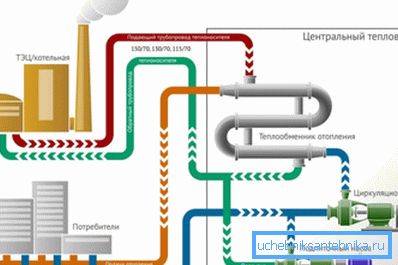
Implementation of wiring
If you decide that the one-pipe scheme is not for you, and decided to give preference to more advanced counterparts, then the information below is for you.
Wiring can be done in two ways:
- Collector - the use of special collectors. By means of them heat will be divorced on all batteries at home. This technology is the most advanced, as it allows you to adjust the microclimate of the premises, thanks to special sensors.
Note! Collectors must be installed at every level of the system.
- Sunbed - involves the installation of a sunbed (most often on the basement). According to him, heat will already be diluted in all radiators. Of course, when choosing such a system, you will not be able to control the temperature, but it costs 20-25% cheaper than the one presented above.
A few final recommendations
In the end, we decided to present some very important recommendations that should help you in accomplishing the task set for you:
- The pipes are best located as straight as possible.. At the same time there should be no right angles. That is, in these places you need to use the appropriate fitting.
- Do not overlap pipes. The fact is that in these places will appear the so-called air plugs that can disable the entire system.
- When choosing a material, give preference to those that are resistant to high temperatures.. Most types of plastic are not suitable for heating systems. It is best to give preference to the familiar to all steel or aluminum. (See also the article Insulation for pipes made of polyethylene foam: features.)
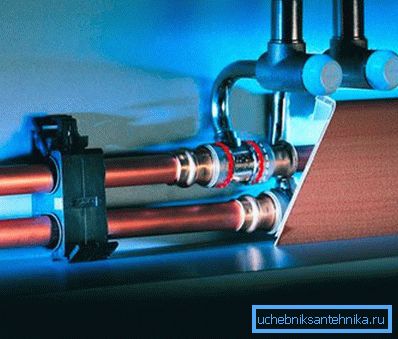
Conclusion
Well, that's all, on this we complete our story. However, if you still do not understand these or other nuances, then do not worry. In the presented video in this article you will find additional information on this topic, which will allow to understand everything.